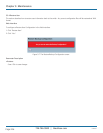
724-746-5500 | blackbox.com
724-746-5500 | blackbox.com
Page 213
Appendix
CCM: CCM is an acronym for Continuity Check Message. It is a OAM frame transmitted from a MEP to its peer MEP and used to
implement CC functionality.
CDP: CDP is an acronym for Cisco Discovery Protocol.
DEI: DEI is an acronym for Drop Eligible Indicator. It is a 1-bit field in the VLAN tag.
DES: DES is an acronym for Data Encryption Standard. It provides a complete description of a mathematical algorithm for
encrypting (enciphering) and decrypting (deciphering) binary coded information. Encrypting data converts it to an unintelligible
form called cipher. Decrypting cipher converts the data back to its original form called plaintext. The algorithm described in this
standard specifies both enciphering and deciphering operations, which are based on a binary number called a key.
DHCP: DHCP is an acronym for Dynamic Host Configuration Protocol. It is a protocol used for assigning dynamic IP addresses to
devices on a network.
DHCP used by networked computers (clients) to obtain IP addresses and other parameters such as the default gateway, subnet
mask, and IP addresses of DNS servers from a DHCP server.
The DHCP server ensures that all IP addresses are unique, for example, no IP address is assigned to a second client while the first
client's assignment is valid (its lease has not expired). Therefore, IP address pool management is done by the server and not by a
human network administrator.
Dynamic addressing simplifies network administration because the software keeps track of IP addresses rather than requiring an
administrator to manage the task. This means that a new computer can be added to a network without the hassle of manually
assigning it a unique IP address.
DHCP Relay: DHCP Relay is used to forward and to transfer DHCP messages between the clients and the server when they are
not on the same subnet domain.
The DHCP option 82 enables a DHCP relay agent to insert specific information into DHCP request packets when forwarding
client DHCP packets to a DHCP server and remove the specific information from DHCP reply packets when forwarding server
DHCP packets to a DHCP client. The DHCP server can use this information to implement IP address or other assignment policies.
Specifically the option works by setting two suboptions: Circuit ID (option 1) and Remote ID (option 2). The Circuit ID sub-
option is supposed to include information specific to which circuit the request came in on. The Remote ID sub-option was
designed to carry information relating to the remote host end of the circuit.
The definition of Circuit ID in the switch is 4 bytes in length and the format is "vlan_id" "module_id" "port_no". The parameter
of "vlan_id" is the first two bytes represent the VLAN ID. The parameter of "module_id" is the third byte for the module ID (in
standalone switch it always equal 0). The parameter of "port_no" is the fourth byte and it means the port number.
The Remote ID is 6 bytes in length, and the value is equal to the DHCP relay agent’s MAC address.
DHCP Snooping: DHCP Snooping is used to block an intruder on the untrusted ports of the switch device when it tries to inter-
vene by injecting a bogus DHCP reply packet to a legitimate conversation between the DHCP client and server.
DNS: DNS is an acronym for Domain Name System. It stores and associates many types of information with domain names. Most
importantly, DNS translates human-friendly domain names and computer hostnames into computer-friendly IP addresses. For
example, the domain name www.example.com might translate to 192.168.0.1.
DoS: DoS is an acronym for Denial of Service. In a denial-of-service (DoS) attack, an attacker attempts to prevent legitimate users
from accessing information or services. By targeting at network sites or a network connection, an attacker may be able to pre-
vent network users from accessing e-mail, Web sites, on-line accounts (banking, etc.), or other services that rely on the affected
computer.
Dotted Decimal Notation: Dotted Decimal Notation refers to a method of writing IP addresses using decimal numbers and dots
as separators between octets. An IPv4 dotted decimal address has the form x.y.z.w, where x, y, z, and w are decimal numbers
between 0 and 255.
LGB1108A


















